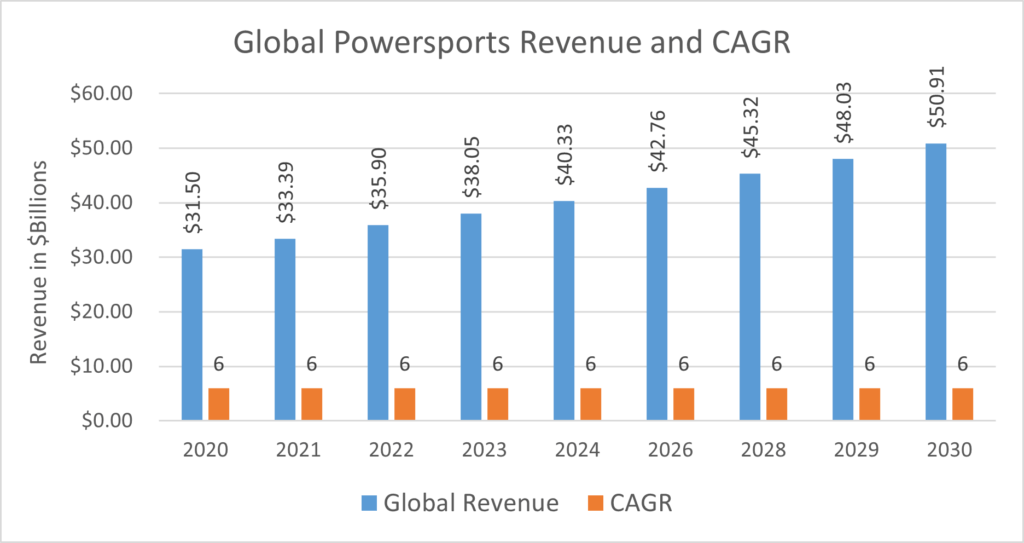Power Systems Research is forecasting global revenue for the Powersports industry to grow from $31.5 billion in 2020 to US$ 50.91 billion in 2030, a CAGR of 6% over the forecasted period.

All-Terrain Vehicles, Side-by-Side, Powerboats, Snowmobiles and Heavyweight Motorcycles
Drivers-of-Demand. There are many factors driving the global powersports market growth:
- Increased all-terrain vehicle popularity.
- These include the rising participation in recreational activities, like surfing, off-road driving, and snowmobiling.
- According to the International Snowmobile Manufacturers Association around $36 Billion is spent directly and indirectly on snowmobiling in the US and Canada each year.
- ATVs have lesser age restrictions, lower maintenance costs, are easier to maneuver due to low vehicle weight and are more affordable
- Rise in use of powersports to boost adventure tourism traveling to new locations for gaining new experiences, with controlled risk components and personal challenges in wild & exotic environments.
- People are raising the bar for racing by introducing new terrains and challenges.
- The market in Europe is expected to showcase exponential growth backed by government policies that promote recreational and off-road leisure activities.
- Global governmental initiatives to boost the tourism industry by assisting recreational clubs in enhancing their service offerings are creating a favorable environment for the market participating in the construction of dedicated infrastructure for recreational and amusement purposes.
- Technological innovations have played a major role in developing vehicles.
- New products have increased comfort, power, engineering, and safety.
- Utility-terrain vehicles (UTVs) have improved durability and adaptability for off-road riding.
- Growth in investments and rapid innovations in the automotive sector have resulted in improved performance of powersports vehicles. This has resulted in improved vehicle efficiency, reduced noise and higher power of vehicles. Companies are also focusing on developing electric products for quieter more powerful riding.
- Growing consumer disposable incomes make it easier for customers to purchase leisure and recreational power equipment.
- Data prepared by the U.S. Bureau of Economic Analysis (BEA) show that outdoor recreational activities accounted for US$ 374.3 billion in 2020, which is 1.8% of the overall U.S. GPD in 2020.
Key Powersports Market Challenge. Powersports provide many positive benefits, but there are some challenges which may hamper the market growth:
- There are detrimental effects of powersport vehicles on wildlife, habitat, vegetation, soil, air, and water.
- Changes in animal behavior, including the abandonment of important activities such as hunting, foraging, and mating, have been linked to the increasing adoption of off-road vehicles. Disturbances from noise, pollution, ground impact, and speed may travel beyond the actual trail surface and affect animal behavior.
- The global power sports market is threatened by restraints such as environmental issues, increasing boomer age and unfavorable weather conditions
- The rapid expansion of the global powersports market could be hindered by rising prices of products, fuel and powersports components.
Due to increasing adoption among younger consumers and cheap loan rates, the motorcycles segment held a significant market share and continues to grow. However, registrations of large-engine motorcycles (600cc and more) have dropped in recent years.
The all-terrain vehicles segment is expected to see high demand. This is owing to numerous advantages of ATVs, like straddle seating position and handlebar steering, the ability of ATVs to travel through all terrains, and lesser carbon emissions. PSR
Michael Aistrup is Senior Analyst at Power Systems Research


